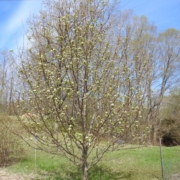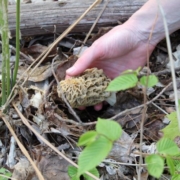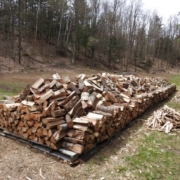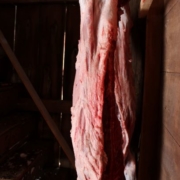Grow a Pear
When I semi-retired from logging in the fall of 2013, I decided to pursue a longed-for endeavor of growing some of my favorite fruit. In the spring of 2014, I began planting like the dickens with my oldest daughter Morgen, who lives next door with her husband and my two favorite (only) grandchildren. Thirty blueberries, some raspberries, two plum trees, a cherry tree, six apple trees, hazelberts (a cross between a hazel nut and a filbert), elderberries, goose berries. And pears. When I was a kid, an uncle of mine had an old pear tree hanging on next to the milk house on his dairy farm in Hinesburg. The pears were the best I ever ate – I never had a store-bought pear that came close to them.
Today we have four pear trees that are doing quite well: a Golden Spice, two Ure, and a Waterville. The Waterville variety was started from a tree growing in an old orchard up in Waterville, Vermont, so we know it’s tougher than wang leather. The Ure’s trace their roots back to Siberia, so pretty tough, too. Both started blossoming earlier this week. And if the frost is gone for good, I’m thinking we might get a decent crop this year.
Our pears have been some of the easiest trees to grow. They seem to have fewer insect problems than other fruit trees. Pollination can be tricky (part of the reason for this is that the blossoms aren’t that sweet, so honeybees don’t love them, especially compared to apple blossoms). But if you plant several complimentary varieties together, it helps stack the deck. It typically takes five to seven years from planting to produce a full crop. And while we’ve only gotten a few pears in the last two years, right now I’m feeling optimistic. These trees have taken the worst that our tough West Bolton weather has thrown at them and came through it. Ain’t lost a one. It makes me trust that there will be sunny, fruitful days ahead.
– Bill Torrey
Morel vs False Morel
Mushroom foraging can be an intimidating hobby on account of the whole some-can-kill-you-if-you-eat-them part. But the reality is that anyone with a reasonable amount of caution, commonsense, and a desire to learn can quickly reach a point where the whole endeavor is as dangerous as crossing a road.
Morel season is underway in southern Vermont, and they’re a great mushroom for a beginner to start with, both because they’re distinctive and delicious. Of course, if you’re new to mushroom foraging, and you’re appropriately cautious and commonsensical, you’ve done your homework and learned that there are these things called false morels, which are toxic and potentially deadly.
Here’s a closer look.
There are two common quote unquote look-alike species that share the woods with morels. One is Verpa spp. (V. bohemica and V. conica are the ones I’m aware of that grow around here). Verpas have a cap and stem that’s sort of like a morel on the outside, but inside they’re filled with cottony material, whereas morels have hollow interiors. I was not able to find one this morning to photograph. Verpa caps overlap their stem and connect at the top, whereas morel caps and stems are seamless. But that might be too much information. Just remember that if there’s cottony material inside, that’s bad. I’ve heard of people eating Verpas on purpose, but most books suggest to steer clear.
The truly toxic look-alikes, and the phrase look-alike is a bit of a stretch, are Gyromitra species. (I believe the one pictured here is G. brunnea.)
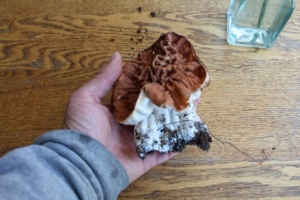
They’re sort of brain-looking in places, which I guess might confuse a novice. But they’re built much squatter than a morel – mature they’re almost round – and any ridges and pits on the cap will not be uniform. You can see from the close-up picture here that the stems are not hollow, so there’s really no mistaking the two if you know this.
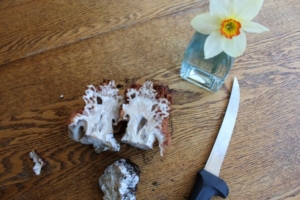
A Gyromitra cut in half. Note substantial, pitted interior.
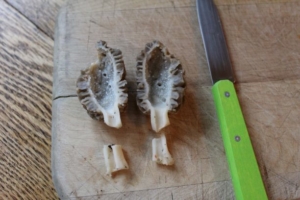
A morel, cut in half. Note hollow interior.
One of the pleasures of working here is that we don’t have a legal department that frowns upon stories about eating mushrooms. No one to suggest we put a disclaimer imploring readers to NEVER ID a mushroom based on something they read online, which undercuts the story and treats you, the reader, like a young child. The way we see things is that if you’ve read this far, you’re an intelligent, curious person looking for reasonable information that you’ll use, along with other sources, to triangulate truth. We hope this is helpful.
The Blackfly Hustle
Editor’s Note: Our friend Bill Torrey, up in West Bolton, sent us this dispatch. We told him to send us more.
It would not feel like spring if I weren’t out there hustling to get the wood I skidded during the winter cut up and drying. I say hustle because I want to be done before the blackflies come out heavily and spoil my fun. I’ve seen a few scouts in the last couple days here and had a confirmed kill yesterday.
I’ve logged the woods most my life and have become quite tolerant of bugs gnawing on me. I’ve dealt with swarms of deerflies the size of pelicans and moose flies big enough to blot out the sun. But blackflies have a special place in my heart for caring enough to drive me to work faster. They remind me that spring will soon be summer. There’s a few that have so much of my blood, they send me Father’s Day cards.
Today I put the last of the split wood onto pallets in a wind-row three pallets wide. I still have to bundle up the kindling I sorted out. In September, after a dry spell, I’ll put a tarp over just the top of the pile to where the stacked outside row is to keep the weather off it. As I was getting ready to head back to the barn, I could’ve swore I had a deerfly buzz me.
The Fragility of the System
For years, critics of factory-farming have pointed out flaws in the system. How big agribusiness puts family farms out of business, which changes the character of rural places. How factory farm operations disconnect farmer and animal, turning living beings into raw commodities. Now, the coronavirus is helping expose another downside – the fragility of a monopolistic system.
A roll-off truck full of hogs from Ohio rumbled into our little Vermont town last Friday. On Saturday morning they were killed and two showed up at my house to get cut into meat. This was an unplanned event. As the big commercial slaughterhouses in the Midwest close (and by big we’re talking facilities that can process a million pigs a year) commercial pig farmers are stuck with no markets. They’ve got hogs that are getting too big – at a certain point slaughterhouses won’t take them – and the next crop of piglets are ready to take the big ones’ place. And so the farmers are stuck. They’re unloading fully-grown pigs for a song to those who want to cut them up themselves. Estimates right now are that 5 to 10 million will be euthanized and disposed of before supply chains unkink, while ironically, grocers are raising the price of pork and preparing customers for a meat shortage. Here’s a newsstory from NPR (the source of the estimate) where you can learn more.
In Vermont we don’t have farms that produce meat on a huge scale like they do in the Midwest. That’s not to say the ripples aren’t being felt here, though. This recent story in Vermont Digger pointed out that some dairy farmers, who are being told to cull their herds to reduce milk production, are finding it hard to find a slaughterhouse to process their beef. Vermont has 13 meatpacking facilities – all tiny when compared to the enormous packers in other states – and they’re booked up for months.
I have all the respect in the world for people who are bravely trying to tame/reform/fix an agricultural system that is in many ways profoundly broken. One way I choose to help – and you can, too – is to unplug from the factory-farm-to-megamart-carousel, where possible. Buy from your local farmer. Or raise animals yourself. In doing so we reconnect with the land and our state’s agricultural roots. We support local. We restore a tiny measure of sanity to food supply chains.
I cut that pork up on mother’s day, keenly aware of where the pigs came from and how dysfunctional the whole endeavor was. A silver-lining, of course, is that I got a pig for next to nothing. A bigger one is that it reminded me to get a locally-raised hog lined up for the fall.

